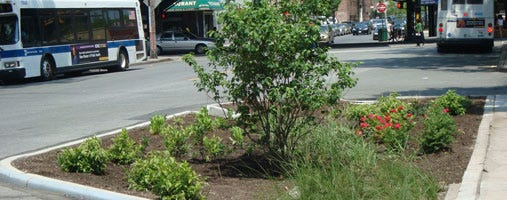Less Flooding, More Yard Variety May Come from Climate Smarts

A Climate-Smart Community Task Force will soon bloom in Port Jervis, says architect Jeremy Shannon, with possible wide-ranging influences on city life, from shifts in lawn vegetation to stormwater management and much else. Shannon initiated the Carbon-Positive Port Jervis 2026 project earlier this year, aiming for the city to produce more energy than it takes from the electric grid by 2026. He hopes to have a role in the task force, which is an element of a New York State Energy Research and Development Authority (NYSERDA) program leading to Climate-Smart Community certification via an elaborate set of requirements in ten categories. Among them are land use, waste management, building technology and codes and community engagement and incentives.
“I hope that in a year we’ll have done much on the list, and Port Jervis people will be behind it,” said Shannon. “There’s a lack of knowledge about Climate Smart Communities.”
He noted other municipalities that have already been working on CSC certification for a while. In two years, Hastings-on-Hudson has made substantial progress .
“They’ve done much we should emulate,” said Shannon, including their “stretch code,” requiring 20% lower energy use and carbon emissions.
He has been discussing the Climate Smart task force composition and direction with city officials and expects participants to be representatives from the Common Council, Department of Public Works and nonprofit organizations, as well as residents with relevant knowledge and ideas.
“The mayor will appoint someone to run the task force, and I hope to be on it, but I don’t have power,” Shannon said. “I want to see what the new Common Council members want, but other things can be done without them. Working groups with break-out committees can amplify efforts community-wide and generate ideas.”
For example, front yard gardens that replace the “monoculture” of grass and nourish the diversity of birds, butterflies and other creatures that enrich the ecosystem could be encouraged and guided by a working group that teaches gardening practices, he said.
“They shouldn’t go to Home Depot and buy Monsanto Roundup that kills everything. They should get native adaptive plants and not just think about aesthetics, but biological diversifying effects. Maybe a $500 prize would be given for best front yard garden to support continued planting.”
Shannon also enthuses about climate-smart storm water management practices that could reduce flooding, as has been a Fourth Ward problem. While adding trees for shade, carbon diversion and visual appeal, green infrastructure can be incorporated around tree trunks in pits that have a permeable top surface and two feet of sand and gravel underneath that holds water.
“Sand columns keep silt from flowing into the river, and tree roots suck up the water,” said Shannon. “Every time you plant trees and add green space, you reduce the carbon footprint. With the green infrastructure tree pits, you lower the cost of water treatment. I haven’t seen green infrastructure and tree projects linked before, but the beauty of the climate-smart community is that the components can work together for exponential benefit.”
At $10,000 per tree pit, this storm water remedy is more expensive than just planting a tree but less than a new storm water system, and tree pits can be added one at a time, Shannon notes. However, tree space along streets is currently too narrow. He hopes for a widening that would come with a Complete Streets grant to accommodate the tree pit strategy.
For the dozens of actions needed for certification, some funding is available through the state Department of Environmental Conservation Office of Climate Change via two funding programs for municipalities. The Climate Smart Communities Grant Program offers funding for a variety of climate adaptation, mitigation and certification actions. Funding is also available through the Municipal Zero-emission Vehicle (ZEV) & ZEV Infrastructure Rebate Program for clean vehicles and for infrastructure to recharge or refuel clean vehicles.
The many activities required for certification will take years to complete, but improvements would appear along the way.
“Daily problems can be addressed with climate-smart actions,” said Shannon.
Community news needs community support to continue. Please consider the various Tri-State Lookout subscription levels.

